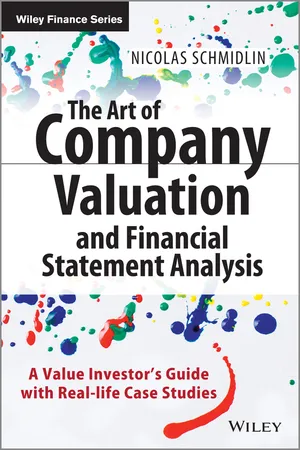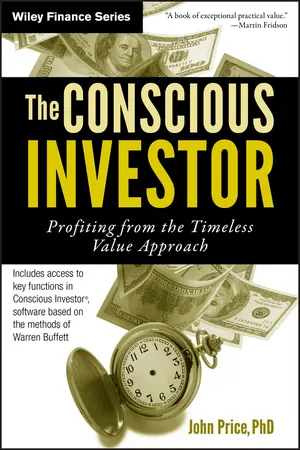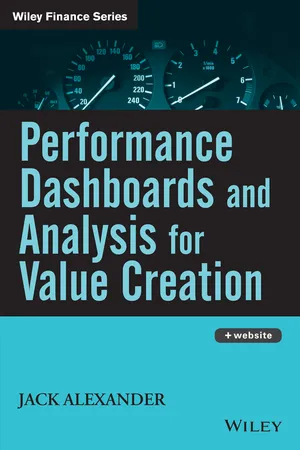Business
DCF Model
The DCF (Discounted Cash Flow) model is a financial valuation method used to estimate the value of an investment based on its expected future cash flows. It involves discounting these cash flows back to their present value using a discount rate, typically the cost of capital. The DCF model is widely used in finance to assess the attractiveness of an investment opportunity.
Written by Perlego with AI-assistance
Related key terms
9 Key excerpts on "DCF Model"
- eBook - ePub
Early Stage Valuation
A Fair Value Perspective
- Antonella Puca(Author)
- 2020(Publication Date)
- Wiley(Publisher)
CHAPTER 6 Discounted Cash Flow MethodJohn Jackmanand Antonella PucaThe discounted cash flow (DCF) method is an income-based approach in which enterprise value is estimated based on the present value of the company's expected cash flows, discounted at a rate that reflects the risk of these cash flows. The credibility of the DCF method lies in a reliable cash flow forecast and well-developed discount rates. The estimate of a discount rate that considers both the prospective of the firm in acquiring its capital resources (cost of capital) and of market participants in pursuing their risk/return objectives (rate of return) is an important step in ensuring that a DCF Model for an early stage enterprise (ESE) is reasonable and consistent with fair value principles.This chapter develops a DCF Model to estimate enterprise value under the fair value standards of ASC 820/IFRS 13, using a venture-backed ESE as an example. After presenting the model's components and key assumptions in some detail, the chapter shows how a DCF Model can be built to reflect the special characteristics of an ESE using a scenario analysis to account for the company's risk of failure. We then discuss how a DCF Model can be calibrated to estimate the fair value of the enterprise in subsequent measurement.1 As we walk through our model, we highlight some key considerations concerning the valuation process and the documentation requirements under the Mandatory Performance Framework (MPF).2In his studies of early stage valuation, Aswath Damodaran has underlined the importance of developing a realistic and internally consistent narrative on the company's path to profitability and to a stage of sustainable long-term growth. The company's narrative should translate into valuation inputs and numbers in a model that can be adjusted at subsequent measurement dates as the company and market environment continue to evolve.3In our example, Racoon Inc. (Racoon) is a revenue-generating company that has already completed its Series B round of financing. The company expects significant revenue growth but is still recording net losses due to a sustained level of research and development expenses and significant marketing costs for the commercialization and distribution of its products. A valuation analyst in a venture capital fund is putting together a model to value the company for financial reporting purposes under ASC 820. More than a year has passed since the company's Series B round and the valuation analyst elects to use a DCF Model in valuation. The analyst estimates the model's cash flows under two scenarios:4 - eBook - ePub
The Art of Company Valuation and Financial Statement Analysis
A Value Investor's Guide with Real-life Case Studies
- Nicolas Schmidlin(Author)
- 2014(Publication Date)
- Wiley(Publisher)
This very simple and abstract example already contains all components needed to determine the intrinsic value of a business: (1) the expected cash flows and (2) the discount rate. Transferred to a real company, however, forecasting (1) and determining (2) is much more difficult. Applying the tools and methods of company valuation and classification introduced in the previous chapters is a necessary precondition for carrying out an assessment altogether. Apart from the theoretically correct assessment of using discounted cash flows as outlined above, this chapter contains further valuation methods. These supplementary and alternative approaches are necessary because, on the one hand, the discounted cash flow method responds to minor changes of the parameters such as the discount or growth rate with significant fluctuations in the result and, on the other hand, the correct prognosis of future cash flows is difficult and error-prone in practice. The intrinsic company value is never an absolute and infallible value, but rather an approximation. The following assessment approaches are used to delimit this value:- discounted cash flow approachd
- equity approach
- entity approach
- APV approach
- market value approach
- fair price-to-earnings ratio
- fair price-to-book ratio
- fair price-to-sales ratio
- fair enterprise value/EBIT ratio
- net asset value approach.
8.1 DISCOUNTED CASH FLOW MODEL
The discounted cash flow approach (DCF) determines the fair company value by discounting future cash flows. According to this theory, the equity and enterprise value of a company are largely determined by its future cash flows and the appropriate discount rate. As parts of this model are commonly based on the theories of Modigliani and Miller, which in turn are problematic in practice, a different route will be chosen to determine the discount factor. Depending on the method, the result is either the value of the whole company, i.e. the fair value of debt and equity, or the fair value of shareholders’ equity directly, which is particularly relevant for investments in stocks.Within the framework of the discounted cash flow valuation, the cash flows of the business which is being valued are normally planned in detail for a time span of 5–10 years and are usually presumed to grow at a constant rate thereafter, which is referred to as terminal value. The value to be determined is therefore composed of the present value of the planning period and the terminal value. If non-operating assets such as unused property or high (net) cash holdings exist, they are often counted towards the final value, without impacting the cash flows. The established discounted cash flow models are divided into the following methods: - eBook - ePub
- Frank J. Fabozzi(Author)
- 2012(Publication Date)
- Wiley(Publisher)
Furthermore, it is not clear how markets would become efficient in the first place, if investors did not attempt to find under- and overvalued stocks and trade on these valuations. In other words, a precondition for market efficiency seems to be the existence of millions of investors who believe that markets are not.Stock-pricing models are not physical or chemical laws of nature. There is, however, a strong principle of investing that must eventually hold true for all firms over time if they are to have a positive value. This principle is that you should always be able, in your mind, to construct some sort of logical connection between a positive stock price today and a stream of future cash flows to the investor. The logical chain might be long. You might assume that years of start-up losses (earnings are zero or negative) will be followed by more years of all profits being reinvested. But you should be able to envision some connection between today’s positive stock price and a stream of cash flows that will commence someday in the future.In this entry, we discuss practical methods of valuing a firm’s equity based on discounted cash flow (DCF) models. Although stock and firm valuation is very strongly tilted toward the use of DCF methods, it is impossible to ignore the fact that many analysts use other methods to value equity and entire firms. The DCF Model is the subject of this entry. The primary alternative valuation method is relative valuation (RV). Both DCF and RV valuation methods require strong assumptions and expectations about the future. No one single valuation model or method is perfect. All valuation estimates are subject to model error and estimation error. Nevertheless, investors use these models to help form their expectations about a fair market price . Markets then generate an observable market clearing price based on investor expectations, and this market clearing price constantly changes along with investor expectations.DIVIDEND DISCOUNT MODELThe dividend discount model - eBook - ePub
Metals and Energy Finance
Application of Quantitative Finance Techniques to the Evaluation of Minerals, Coal and Petroleum Projects
- Dennis L Buchanan, Mark H A Davis(Authors)
- 2018(Publication Date)
- WSPC (EUROPE)(Publisher)
For mineral projects, particular attention has to be paid to the treatment of the key independent variables such as grade, and dependent variables, such as grade-tonnage relationships, and the way these influence the rate of mining, associated costs and optimisation of the value of a project. Petroleum projects are based on initial volumetries, segment production and annual production profiles, revenue, operating costs, and capital costs.The distinction between technical appraisal and financial factors will also be addressed and the reason why discounted cash flow (DCF) models need to be integrated correctly into financial accounts explained. This will be linked to concepts of shareholder value and the role of gearing to maintain an efficient balance sheet.2.2Principles of DCF Modelling
As a starting point in building a DCF Model for a mineral project, it is often assumed that the projects are at the pre-production and preinvestment stages. The principle of DCF is based on the logic that money received in the future is worth less than that same amount received today, due to the opportunity for earning additional revenue on that sum if it were to be invested elsewhere. Suppose there is a choice of receiving $1,000 today and investing it or receiving $2,000 in 10 years’ time. Which is the most valuable outcome? The answer clearly depends on the prevailing interest rate. If it happens to be 5%, the money would be worth $1,629 at the end of 10 years and so it would be better to wait. On the other hand, if the current rate happens to be 10%, the sum would be worth $2,594 in 10 years’ time and so it would be preferable to take the money now and invest it. The breakeven interest rate in this scenario is about 7.2%.Modelling incremental DCF analyses the financial viability of a project by not only testing that generated revenues are substantially greater than costs and debt service requirements, but also by measuring the present value of those profits. The underlying philosophy in DCF analysis is that the project is to be compared with investing the same stream of cash flows elsewhere.One of the essential questions in DCF analysis is how to choose the discount rate. At the pre-funding stage, this is essentially set by the investor or the new business division of the natural resource company. DCF can then be used to determine the net present value (NPV) of the project, which is essentially a present valuation of the potential of the deposit to generate future profits. NPV is calculated as follows: - eBook - ePub
- Steven M. Bragg(Author)
- 2010(Publication Date)
- Wiley(Publisher)
Exhibit 22.11 .Exhibit 22.11 Discounted Cash Flow ModelThe buyer should beware of models where the terminal value is by far the largest component of the model; the terminal value is the least predictable part of the valuation, because it is the furthest into the future and assumes a specific sale price that is very difficult to justify. If the terminal value is the bulk of the DCF, then the buyer will need to supplement the DCF analysis with other forms of valuation analysis.A major part of the DCF analysis is the interest rate that is used for discounting the value of future cash flows to the current period. This interest rate is equivalent to the buyer's incremental cost of capital. The cost of capital is the weighted average cost of the buyer's debt, preferred stock, and equity. The cost of equity is the most difficult to determine, but usually involves the capital asset pricing model. On an extremely simplified basis, the cost of equity is at least 5 to 7 percent higher than the current interest rate on U.S. government treasury notes, and can be substantially higher. As an example, Exhibit 22.12 shows the dollar amount of the three components of a company's cost of capital, yielding a weighted average cost of capital of 10.7 percent.Exhibit 22.12 Weighted Average Cost of Capital CalculationIt is preferable to use the incremental cost of capital, which incorporates the buyer's most recent cost of debt. The incremental rate is better, because that is the rate at which the buyer will need to obtain funding to pay for the target.It is also possible to adjust the cost of capital for the perceived risk of the target company. For example, if the target is a well-established one with predictable cash flows, the buyer can simply use its cost of capital as the discount rate. However, if the target's cash flows are more uncertain, the buyer can add a risk percentage to its discount rate. By doing so, cash flows that are further in the future will be worth less in the DCF, resulting in a lower valuation for the target. - eBook - ePub
- Frank J. Fabozzi(Author)
- 0(Publication Date)
- Wiley(Publisher)
Although stock and firm valuation is very strongly tilted toward the use of DCF methods, it is impossible to ignore the fact that many analysts use other methods to value equity and entire firms. The DCF Model is the subject of this entry. The primary alternative valuation method is relative valuation (RV). Both DCF and RV valuation methods require strong assumptions and expectations about the future. No one single valuation model or method is perfect. All valuation estimates are subject to model error and estimation error. Nevertheless, investors use these models to help form their expectations about a fair market price. Markets then generate an observable market clearing price based on investor expectations, and this market clearing price constantly changes along with investor expectations. DIVIDEND DISCOUNT MODEL The dividend discount model (DDM) is the most basic DCF stock approach to equity valuation, originally formulated by Williams (1938). It states that the stock price should equal the present value of all expected future dividends into perpetuity under the assumption that a firm has an infinite life. But you may also have ignored the DDM once you recognized how difficult it is to apply in the real world. The next several paragraphs simply review the basic concepts in order to highlight the complexities that surround implementing the DDM in practice. Consider an investor who buys a share of stock, planning to hold it for one year. As you know from previous studies, the intrinsic value of the share is the present value, P (0), of the expected dividend to be received at the end of the first year, ED (1), and the expected sales price, EP (1). (1) Keep in mind that since we live in a world of uncertainty and no human can perfectly forecast the future, future prices and dividends are unknown. Specifically, we are dealing with expected values, not certain values - eBook - ePub
- A Macleary, A. Macleary, N. Nanthakumaran(Authors)
- 2003(Publication Date)
- Taylor & Francis(Publisher)
CHAPTER 3 THE CURRENT DISCOUNTED CASH FLOW MODELS FOR THE VALUATION AND ANALYSIS OF PROPERTY INVESTMENTS: AN EXAMINATION OF SOME OF THE PROBLEMS1 Introduction
Methods of property investment valuation and analysis have been subject to much criticism over the past decade. Indeed, the scrutiny of conventional methods has its origin in the research carried out by Greaves: 1972 and Wood: 1972. Both Greaves and Wood were very critical of the conventional methods and called for the use of discounted cash flow models in property valuation and analysis, but the response from the property profession has been very disappointing.Recently two DCF Models have been formulated for the valuation of property investments. They are the Rational Model (Mclntosh and Sykes: 1982) and the Real Value Approach (Crosby: 1983). These models are based on similar assumptions but in their applications they take slightly different forms. The applications of these models for the valuation of freehold reversions and leaseholds have been reviewed by Baum: 1984, and Baum and Yu: 1985.The purpose of this chapter is to examine some of the problems that are involved in the use of contemporary discounted cash flow models for property investment valuation and analysis. This chapter examines the application of these models, the assumptions on which they are based and their limitations in certain situations. The equated yield version of the DCF Model is considered in this chapter, but the comments should be equally valid for the Rational Model and the Real Value Approach.2 Discounted cash flow models
The discounted cash flow models can be used for both valuations and analysis (or appraisal). The purpose of a valuation is to estimate the market price of an investment in property. An appraisal (or analysis) is usually undertaken to estimate the investment worth of a property investment to a particular individual, based on his estimates of rental growth, yields and risk attached to the investment. - eBook - ePub
The Conscious Investor
Profiting from the Timeless Value Approach
- John Price(Author)
- 2010(Publication Date)
- Wiley(Publisher)
Table 7.4 is replaced by 6 percent, the intrinsic value increases to $86.48. If it replaced by 9 percent, it jumps to $143.06. The underlying problem is that the actual method is encumbered right at the start with the requirements of making forecasts out to infinity. So problems and inconsistencies are always going to occur.Strengths and Weaknesses of Discounted Cash Flow Methods
Prior to the work of Robert Wiese and the book by John Burr Williams mentioned at the start of this chapter, there was no systematic understanding of how to value a company. The advent of valuing a stock as the discounted value of a stream of payments was a major development in establishing a clear difference between investing and speculating. We start with the strengths of the discounted cash flow method:Strength 1: Clear definition. The definition is quite specific in terms of the input variables and the calculations used to combine them. Under various assumptions the method is amenable to being programmed and, with care, can even be calculated using a calculator or spreadsheet.Strength 2: Rational definition. A standard bond consists of a series of dividends plus the return of the face value at its expiration. Consequently, its value is calculated as the discounted value of the dividends plus the discounted value of the face value. The definition of value of a stock using the DCF approach is a rational extension of the calculation of value of a standard bond.Strength 3: Easy interpretation. It is easy to interpret the outcome of a DCF calculation as the true value of a stock and to compare this value with its market price in order to facilitate buy/hold/sell decisions.Strength 4: Wide applicability. The method is applicable to a wide variety of companies and not just to those that are publicly listed. For example, it is commonly used to value small private companies looking for new investors or as part of the prospectus for larger companies planning to list on a stock exchange.Strength 5: Easy conversion. By dividing the terms in the basic DCF formula for intrinsic value V by the price P - Jack Alexander(Author)
- 2011(Publication Date)
- Wiley(Publisher)
The DCF valuation method can be utilized to estimate the total value of the firm or the value of equity. Typically, we estimate the total value of the firm by projecting total cash flows available to all investors, both equity and debt. We then discount the cash flows at the weighted average cost of capital (WACC), which is an estimate of the returns expected by investors. Discount rates and the cost of capital are explored in greater detail in Chapter 10.Step 5: Estimate the Value of the Firm and Equity
The resultant discounted cash flow is the total value of the firm, also referred to as the enterprise value. To compute the value of equity, two adjustments must be considered. First, if the firm has a substantial cash reserve, this amount is added to the discounted value of projected cash flows. Second, in order to compute the value of equity, we deduct the value of the debt. The estimated value of an individual share can then be determined by dividing the market value of equity by the number of shares outstanding. Where there are significant stock options or other common stock derivatives outstanding, these should also be considered in the share count.One of the criticisms of discounted cash flow is that it requires assumptions about the future. In fact, this is actually a major strength of DCF analysis. We all recognize that it is not possible to predict the future, including specific projections of sales, costs, and numerous additional variables required for completing a thorough DCF analysis. However, by using sensitivity analysis, we can identify and quantify the sensitivity of shareholder value to key assumptions. The analysis allows us to identify the most critical factors impacting the value of a firm, such as revenue growth and profitability.ESTIMATING VALUE BY USING THE VALUATION OF SIMILAR FIRMS: MULTIPLES OF EARNINGS, CASH FLOW, AND RELATED MEASURES
The other commonly used valuation technique is based on using measures of revenues, earnings, or cash flow and capitalizing these amounts using a multiplier that is typical for similar companies. These methods are essentially shortcuts or rules of thumb based on economic theory. Users of these methods tend to establish ranges for certain industries. For example, retail companies may trade at a multiple of 0.5 to 1.0 times revenues, while technology companies may trade at 2 to 3 times revenues, or higher. The significant difference between the multiple for the two industries is explained by many factors that are independent of the current revenue level. For example, expected growth in revenues, profitability, risk, and capital requirements will impact the revenue multiple. Those familiar with the business characteristics of specific industries, such as market growth, profitability, risk, and capital requirements, can use the method effectively.
Learn about this page
Index pages curate the most relevant extracts from our library of academic textbooks. They’ve been created using an in-house natural language model (NLM), each adding context and meaning to key research topics.








